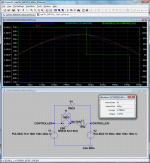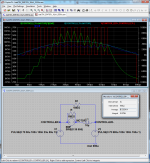c_a said:
yes ?

c_a said:
the problem is not the inductance, it is not the resistence, the pwm frequency or the timing.
The problem is all together!
I've been thinking about circuit's 3uH motor problem, I mean, such a high ripple current at such a low maximum current, there has to be something wrong....
Lets see which things we can change given a certain motor topology... The problems seems to be that
slope_to_useful = (dI/dt) / I
is too high. Here dI/dt is the slope of the ripple current, this is divided by the (wanted usefull) current I. And this ratio has to be as low as possible.
dI/dt is from the inductor and is equal to V/L .
V is proportional to the motor's back-emf. The bck_emf is proportional to magnetic field strength, stator tooth area, motor speed and the
number of windings N. Since the mechanical bits are all given (unchangeable) and we can only change the amount of windings N, here all we need to use is:
V is proportional to N.
In the same way for the inductance L, this depends on all kinds of factor which we cannot change, and the amount of windings squared. Therefore
L is proportional to N^2
I is the current we put in. We are basically free to choose it's value but at a certain point the stator will saturate. This happens for a certain amount
of AmpTurns. This max 'AmpTurns' is again a property of the motor design and material used, unchangable. Using this:
I = AmpTurns / N
Substituting all this in the first equation (=~ means: is proportional to):
slope_to_usefull = (dI/dt) / I =~ (V/L) / I =~ (N / N^2) * (N/AmpTurns) = 1/ AmpTurns
I just make this up as I go along so if I go wrong somewhere let me know but I got the idea that
slope_to_usefull =~ 1 / AmpTurns
and that the amount of AmpTurns should be as high as possible. AmpTurns is bound to a maximum as above a certain value the core
saturates. To keep the slope_to_usefull ratio in check the motor should be operated as close as possible to its AmpTurns maximum.
Also, if the stator design is not very good (like thin stator teeth for instance) the AmpTurns_max is low and the motor has a high slope_to_usefull
ratio. It can still be run fine but it needs a high PWM to keep the ripple in check.....
B!tch is that the resistive losses are proportional to AmpTurns squared
P_loss = I^2 * R
R is the winding resistance, it's proportional to wire lenght and wire cross section area
R =~ length / wire_area
length is proportional to the amount of windings N. Wire_area is proportional to the area allowed by the stator tooth design divided by N. The available
area between stator teets is a motor property which we cannot change so
R =~ N / (1/N) = N^2
Therefore
P_loss =~ (AmpTurns/N)^2 * N^2 =~ AmpTurns^2.
So the happy conclusion

is:
Just increase your resistive losses and your motor controller will be fine !
life sucks





